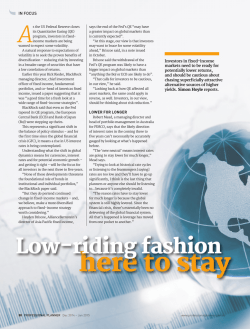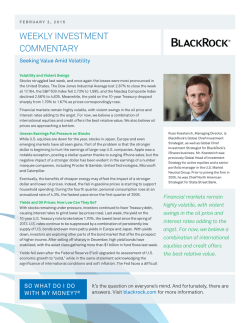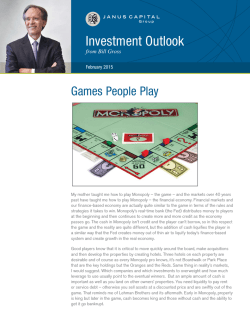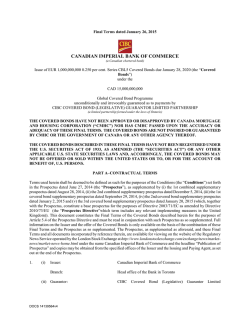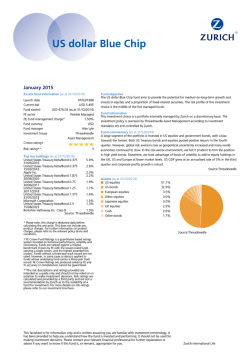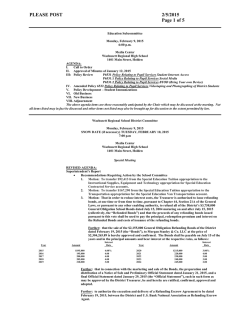
Demographic Pulse Issue 10
Issue # Allianz SE www.allianz.com 10 Allianz Demographic Pulse February 2015 Save smart, not hard – with life cycle investments Grandfather, father, son – each of them is saving differently. The goal is to be financially secure at old age. The Western world is still being affected by historically low interest rates. However, if returns continue to fall, poverty in old age will no longer be an unlikely scenario. It makes sense to invest based on life stages. Smart investment based on life stages – how to escape poverty in old age Since the start of the crisis on the financial markets, 1,500 EUR have been lost per capita. In Europe, every third euro of financial assets is held in zero percent interest bank accounts. With government bond markets reaching new yield lows the paradigm of financial repression is now more relevant than ever before. Financial repression means that savers are paying the price for government debt by way of unnaturally low interest rates; even though the predominantly rising government debt ratios are at odds with the decrease in yields across the Eurozone. It might be great for the finance minister, but it‘s a nightmare for investors. According to Deutsche Bundesbank, for savers in Germany, this means a total loss of 120 billion euros in interest income since the outbreak of the financial crisis. That represents some 1,500 euros per person, regardless of whether you are a baby or old age pensioner. Hoping for a swift end to this period of low interest rates is likely to ultimately lead to self-inflicted poverty in old age, since very little is left of these yields once inflation has been deducted. Central banks, above all the US Federal Reserve, are pursuing a consistently expansive policy. They are flooding markets with liquidity, more than the economic situation would normally allow. This is the result of the clean-up operation in answer to the US property market and euro debt crises. There is still a long way to go before the flood of liquidity dries up. The large government bond holdings that the Central Banks of the important G4 countries (eurozone, Japan, UK and the US) have on their books, and the base interest rate policies that can conceivably be expected from the continually low financial market rates, will result in interest rates remaining persistently low over the entire term for a long time to come. This is bad news for anyone counting on bank deposits and government bonds as a source of return, and building up their retirement provision on it. The lower the yields, the lower the compound interest effect which is so important for the saving process. The challenging thing about it is that a large portion of financial assets in Europe is nonetheless invested precisely in this form. As Allianz’s “Global Wealth Report 2014” shows, every third euro of financial assets in Europe is just sitting in a bank account earning nothing, instead of doing some work. This period of low interest rates really makes itself noticed here. The proportion of sedentary financial assets is even greater in certain European countries as some examples show: In Germany this figure amounts to 40 percent, in Portugal 39 percent, in Austria 45 percent, and in Spain as high as 47 percent – almost half of the country’s financial assets. Let the money work So what can be done? As low yields threaten the build-up of assets and retirement provision, investors are left with just two possibilities: They increase their savings contribution in order to balance out low yields or they invest more heavily in investment types that tend to have a higher risk, but correspondingly offer higher potential yields. As a first step, this could be bonds issued by companies or emerging economies. However, as a rule, they generate higher returns due to the higher issuer risk associated with them. Institutional investors are also increasingly investing in infrastructure. This involves high-volume project financing meaning participation by private investors with smaller investment sums is often not possible. Real yields on ten year US treasuries and German bunds are decreasing 10 % 8% 6% 4% 2% 0% Source Datastream; Global Capital Markets & Thematic Research Allianz GI -2 % 1986 1988 1990 1992 1994 Allianz Demographic Pulse issue #10 February 2015 1996 1998 2000 2002 2004 2006 2008 2010 2012 2014 page 1 The balance sheets of the G4 central banks are still expansive 4,0 % 12 trn USD Average key interest rate 3,5 % 10 trn USD 3,0 % 2,5 % 8 trn USD 2,0 % Total assets of the G4 central banks 1,5 % 6 trn USD 1,0 % Source: Datastream, Allianz GI Capital Markets & Thematic Research 4 trn USD 0,5 % 0,0 % 2 trn USD 2008 2007 In industrialized countries above all, the standard of living has enormously increased over the past 200 years. 2009 2010 Investors should also think about equities. Admittedly, studies carried out by Allianz Global Investors have shown that equity prices are more volatile than bond prices. But as a rule long-term oriented investors will be rewarded for taking on higher risk with a higher risk premium. Historically, equity investment has been a success story. A simplifying example: With the equity portfolios of their great-great-great-grandparents at the equivalent value of what back then was 10 US dollars, heirs today would be millionaires, with assets valued at approximately 1.5 million US dollars. Over the last 213 years, the price of the American stock market has climbed in line with the growth of US corporate earnings. The S&P 500 (Standard & Poor’s) share index rose by 1,843 index points in the period from 1871 to 2013; an average nominal increase of around 4.3 percent per annum. If the reinvested dividend premiums, whose returns amounted on average to 4.4 percent and 2011 38 % 28 % 56 % 26 % 29 % 37 % 40 % 36 % 23 % Austria 35 % 45 % 19 % Italy 47 % Spain 34 % Portugal 47 % 33 % 31 % 13 % 54 % 26 % 32 % 39 % 16 % 54 % 17 % 31 % 19 % 16 % USA Asia ex Japan 32 % 38 % 13 % Germany Japan 29 % 31 % 27 % France 2014 Asset class as a percentage of gross financial assets + Other receivables + Insurance and pensions + Securities + Bank deposits World Europe 2013 constituted a good half of the performance, are added on to that, this results in a performance index to the equivalent of over 800,000 index points. This corresponds to a historic rise in the S&P 500 of 8.7 percent per year. Looking at its fundamental basis, real economic growth, we can see that general prosperity has grown enormously over the last 200 years, especially in industrialized countries. Measured against real Gross Domestic Product (adjusted for inflation), since 1800 average yearly growth in the US, UK and France has amounted to a range of three to four percent, and around four percent per year in emerging markets. In the past, shareholders who had a stake in the productive assets of a company by way of equities, or, on a macroeconomic level, in a national economy, were able to be part of this prosperity. A lot of money is invested in low yielding bank accounts UK 2012 16 % 51 % Source: Allianz Global Wealth Report 2014 Allianz Demographic Pulse issue #10 February 2015 page 2 Don’t forget to think about investing in equities Risk premium of US shares vis-à-vis US government bonds (rolling 30 year yields) + Risk premium of US shares versus US government bond 12 % 10 % 8% 6% 4% Source: Jeremy Siegel database 1801–1900 & Elroy Dimson, Paul Marsh, and Mike Staunton 1900 – 2009, Datastream Allianz Global Investors, Global Capital Markets & Thematic Research; Dec 31, 2013 2% 0% -1 % 1831 1841 1851 1861 1871 1881 1891 1901 1911 1921 1931 1941 1951 1961 1971 1981 1991 2001 2011 Optimize the share proportion The higher the expected employment income over the remaining lifespan, the higher the amount that can potentially be invested in investments with a slightly higher risk than bonds. To optimize the proportion of shares, a rule of thumb can be helpful. The most significant factor driving this development was the risk premium. This is the extra return that an equity investor receives compared to a risk free investment. Let us stick with the example of the US because of the length of the time series: Here the historical average risk premium over the last 213 years amounted to 3.7 percent per year. Three things can be learnt from this historical observation: 1. When building up assets it comes down to the preservation of purchasing power. The effect of inflation must also be taken into consideration. 2. Therefore, when it comes to longer periods of investment, you shouldn’t forego the risk premium. 3. In order to bring expected risk in line with expected yield, a mix of bonds and equities is a good option. But what should this mix look like? What proportion of equities should there be in your portfolio? Basing your investments on your life cycle can be a helpful indication of what a suitable shareholding in your securities deposit account could be. Using this model, your shareholding will evolve as you get older. The idea behind it is that your whole life can be interpreted from an assets point of view as cash flow, which feeds on your income from employment and income from assets. Your own working capacity can be viewed as a bond, which pays a monthly coupon, a fixed interest, which is your salary. The older you get, the closer you get to retirement. The coupon that is your working salary decreases and the coupon payment that is your pension takes its place. Since your income from your salary and pension is guaranteed thanks to unemployment and pension insurance, this is Allianz Demographic Pulse issue #10 February 2015 a less volatile type of income – just like a bond. The consequence is that the higher the expected employment income over the remaining lifespan, the higher the amount that can potentially be invested in investments with a slightly higher risk than bonds. As you get older, the number of these assets should be slowly reduced in favor of more stable ones. But even when you go into retirement the number of higher-yielding forms of investment does not need to be knocked down to zero: You will still have your pension, and based on average life expectancy you could still have long years to come and plenty of time to ride out price fluctuations. Based on this line of thinking, how should the proportion of equities in a securities deposit account change? If you carry out your strategic asset allocation based on this rationale, you‘ll optimize your asset allocation not just by way of your financial stocks, but also your human capital, that being your income from employment. The previous considerations give rise to a simple rule of thumb that should help build a bridge to figuring out how to allocate your shares. This rule of thumb suggests that equity allocation should equate to your own life expectancy minus your current age. Share quota = 100 – x Since a forty year old man in Europe today has a life expectancy of just below 75 years, and a woman of the same age 81 years, simplifying life expectancy to 100 years for this calculation is not unreasonable. A further coupon, your pension, also runs to the end of your life, even if this will certainly amount to less than page 3 your employment income. If you subtract another year of life every year, and decrease your share allocation by one percent accordingly, then this will sink to 0 by the ascribed end of your life aged 100. This rule of thumb is a rough simplification of course, but it corresponds pretty well to the logic set out in this study: Equity allocation reaches its peak upon entry into professional life, and is reduced step by step from that point. The fact that a person’s equity allocation is still very small before entering a career can be explained by the fact that the coupon that is their income from employment is not flowing yet. It is advisable to invest in less volatile assets for this reason. Of course it is also the case here that the individual’s investor profile – personal risk appetite for example – must be taken into consideration. The following simplified example shows what saving based on your life cycle can mean: An investor begins to save aged 40 and sets aside 50 euros every month until he turns 60. As he is fairly risk-averse, he deviates slightly from our model: From the age of 40 to 50 he invests the money in a mixed fund consisting of 40 percent equities and 60 percent bonds. Then at 50 he reduces the number of equities to 30, and again aged 60 to 20 percent. He obtains an average of 7 percent return on his equities. We will carry on with the assumption that the unusually low level of return on bonds normalizes over time, and that the investor does not just rely on government bonds, but also on corporate bonds and bonds from emerging economies for example. With this in mind, we will take the average yield from bonds to be 3 percent. Aged 60, the investor will then have approximately 35,000 euros at his disposal. For the purpose of comparison, if he had just invested in bonds, he would only have amassed just over 16,000 euros. These are modelling assumptions, but they show what a higher yield expectation can lead to. Here are tips for investors: • In times of financial repression, investors should also back risk premiums offered by equities as opposed to bonds. • The more risk-free an investor’s income from employment is and the longer they will continue to receive it, the higher risk the investment can be. Publisher Allianz SE Life expectancy in Europe for 40-year-old men and women men women World 75 79 Europe 75 81 UK 80 83 France 80 86 Germany 80 84 Austria 80 82 Italy 80 85 Spain 80 86 Portugal 79 84 USA 79 83 China 76 79 India 71 75 Japan 81 88 Source: United Nations Population Division; World Population Prospects, the 2012 Revision • The opposite is also true: if your income from employ- ment is at a higher risk, then your investments should be more stable. Income from employment can be high-risk if you are self-employed, for example. • The advantage: once you have divided your assets into equities and bonds, you will then only need to make small adjustments over time. So-called mixed funds, which concentrate on both asset types, are welldesigned for this. These offer varying proportions of shares and bonds, and can be easily linked to your life insurance. • Smart investment based on life stages can serve as stable base for old-age provision. Author: Hans-Jörg Naumer Global Head of Capital Markets & Thematic Research, Allianz Global Investors, Allianz’s investment fund company. Overall responsibility Petra Brandes Group Communications Alllianz SE [email protected] Editorial team Petra Brandes Julia Pfeil Website www.allianz.com Twitter @brandes_petra Copyright © 2014 Allianz SE. All rights reserved. Allianz SE Koeniginstrasse 28, 80802 Munich, Germany Commercial Register: Munich, HRB 164 232 Allianz Demographic Pulse issue #10 February 2015 page 4
© Copyright 2026
